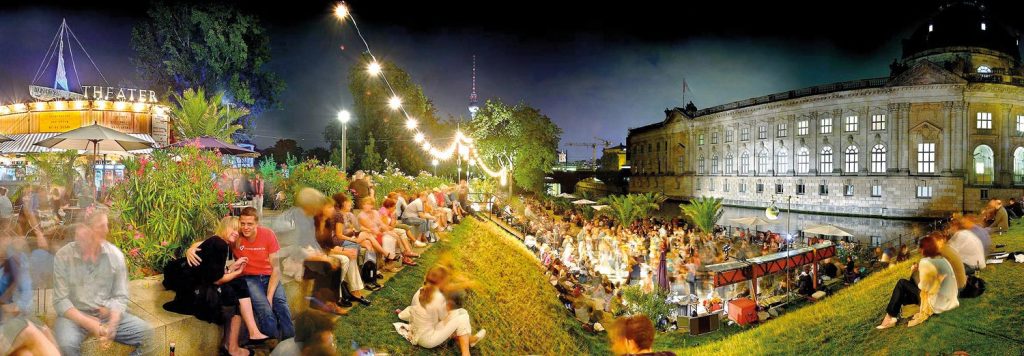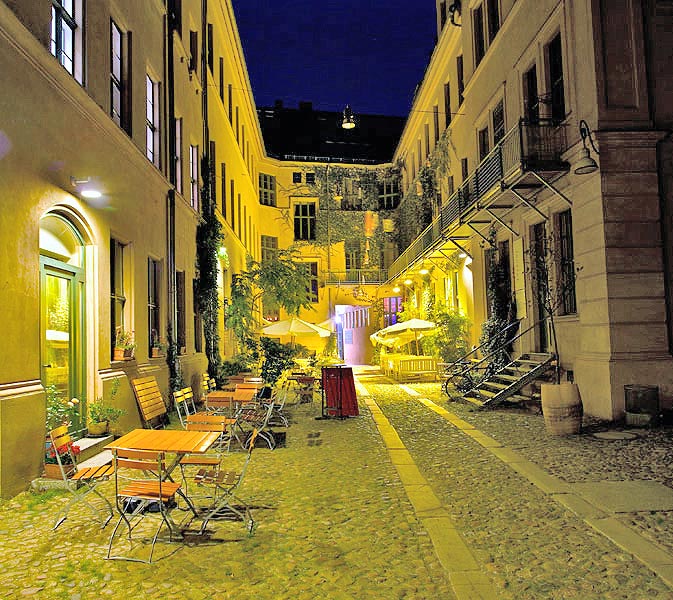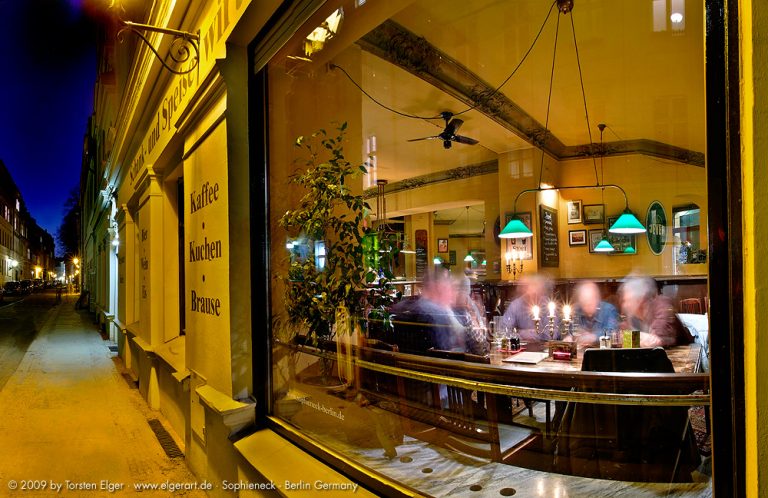
The Kiez, the Spandauer Vorstadt
Berlin's first mention was in the middle of the 12th century. After the Thirty Years' War (1618 – 48) a bastion with a fortification was built as protection, 13 gates were built around Berlin. The most famous was and is the Brandenburg Gate, from 1735 on the fortification was demolished.
Spandauer Vorstadt, formerly Feldmark at the gates of Berlin, was crossed by trade routes, e.g. towards Hamburg — Grosse Hamburger Straße, towards Oranienburg — Oranienburger Straße
The Große Hamburger Straße
is located in the middle of the Spandauer Vorstadt, which means: city at the gates of Berlin in the direction of Spandau.
Sophienkirche
Protestant parish church it was built in 1712 – 13 as a classic Brandenburg parish church. 1729 – 35 the only preserved baroque tower of the city was added, in 1892 the Sophienkirche was extended and rebuilt in new baroque style, the old entrance in Sophienstraße was moved to Große Hamburger Straße.

Jewish boys' school,
a new building was erected here in 1863, and in 1906 the present facade was built.

Jewish retirement home,
was founded in 1829, from 1941 the Gestapo set up a collection camp in the old people's home, more than 50 000 Jews were sent from here to be deported and exterminated, in 1945 it was destroyed.
This memorial – as well as the one in the memorial of the women's concentration camp Ravensbrück – was created by the artist Will Lammert.

Jewish cemetery,
oldest, demonstrable cemetery of the Jews in and near Berlin, 12000 people were buried here by 1672 – 1827 In 1943 splinter trenches were dug on the orders of the Gestapo and this site was destroyed. In 1945 the dead were buried again, 2500 people, war victims from surrounding streets.
1786 Moses Mendelsohn was buried here


The Koppenplatz,
it is located at the northern end of the Große Hamburger Straße.
Koppenplatz,
here, across the Große Hamburger Straße stood the hospital for the poor, behind it the cemetery for the poor, city captain Koppe had bought land here in 1696, in 1705 he donated the cemetery, in 1708 then a hospital. This hospital stood at the end of Große Hamburger Straße, hence the bend and the continuation of the street through Kleine Hamburger Straße to the city gate.
Koppe died in 1721, in 1755 the city donated his funerary monument, which Stüler erected, it is probably the only street grave outside Italy.


School of L. Hoffmann,
1902 – built in 1907, typical for his school buildings are the clock tower and many animals in the building. In the meantime the building was used by theatre groups. Since 2008 it is used as a school again – Primary school at Koppenplatz.



Hollmannsche Stiftung,
located just behind it, it was built around 1850 for widows and daughters of higher officials.
The Oranienburger Strasse,
a former trade route through the Feldmark in the direction of Oranienburg, it was laid out as an army road, hence its size
Monbijou Castle, Monbijou Park
which means "my jewel." In the middle of the 17th century the electoral garden was located here, after further alterations in 1717 it was considered the most beautiful palace of the Residenz, after war meetings it was torn down in 1960.
Anglican Church,
in the castle park was consecrated in 1885 and used until 1939, in the fifties it was demolished.
What remains is Monbijou Park with the children's outdoor pool.
During the summer months, the open space opposite the Bodemuseum is transformed into a dance floor. Salsa evenings and tango-milongas take place here regularly.

New synagogue,
Built in 1866 by the architect Knoblauch, it was supposed to be set on fire by the Nazis, but the then district chief Krützfeld thwarted this plan. In 1943 it was badly hit by air raids, from 1988 the preserved remains were restored to stand the test of time as a reminder.

Post Office,
at this place stood (1705) the postillion house. The architects Tuckermann and Schwatlow built a representative new building in 1875 – in 1881, the main room was used by the CO GALLERY as an exhibition space until 2014.
Parcel Post Office
Masonic lodges house,
with classicistic facade, since 1791 religious house, sold to the Reichspost in 1898. Restored in 1962, both keystones left and right of the entrances, Socrates on the left and Seneca on the right have been preserved.



The Kunsthof and the Heckmannhöfe,


Auguststrasse
Gallery-Mile Auguststraße,
This street has become famous for its countless galleries (including the gallery "eigenart", the "KunstWerke – KW"), which were mainly established here in the post-reunification period. Juta Weiz, former employee of the WBM, played a very large part in this.


Jewish girls' school,
Auguststrasse 11 - 13,


Sophienstrasse
Sophia Street,
In former times it was also called Kirchgasse or Kirchhofgasse, it was externally restored for the 750th anniversary of Berlin 81987). Here you can still find small two-storey Biedermeier houses, opposite the old main entrance of the Sophienkirche is the former entrance of the Handwerkervereinhaus, in its courtyard are the famous Sophiensäle, which were unique in their size in the suburbs.


Craftsmen's clubhouse,
Sophienstraße 17 / 18, here the new building of the workers' organisation was erected in 1905, the house served educational purposes, in the courtyard there were several large halls, the largest one held 3000 people. Because of the ban on assembly, political organizations and parties from all camps met here. In the 20's and 30's the wrestling clubs held a rendezvous, a kind of criminal society, they supported e.g. the women and children whose husbands were in prison.

Around the Hackescher Markt
Neue Schönhauser Strasse, Rosenthaler Strasse, Hackescher Markt
Hackescher Höfe,
here are 8 farms, at that time the largest farm complex in Europe, 1906 – built in 1907. Here one should live and work, there were many small factories, stamp, rubber and shoe manufacturers, a wax factory and the like. Today there is a mixed use of industry, cinema, theatre and apartments.



House Schwarzenberg,
the name comes from the novel "Republik Schwarzenberg" by Stefan Heym and is based in the village of the same name in Thuringia. At the end of the war in 1945 an independent republic was proclaimed for a few days in the village of Schwarzenberg. The place was forgotten by the Allies when Germany was divided into occupation zones.
Thus this farm ensemble is just as special in the area that is now mainly used for commercial purposes.
Occupied by artists during the reunification, it was acquired by the housing association and could be given to the e.V. Haus Schwarzenberg for use. Thus an important cultural centre in the Spandauer Vorstadt was preserved.
In addition to studios for artists, there is a highly recommended bookshop with a gallery (e.g. with unique copies and small editions of various artist catalogues), the museum "Stille Helden - Blindenwerkstatt Ottto Weidt", the Anne Frank Centre, a cinema and as a special highlight the Monsterkabinett (fantasy figures as mechanical dolls).

New Schönhauser,
Corner of Rosenthaler Straße, this street was built on the city wall, it follows the course of a narrow path below the fortification, clearly recognizable by the bend in the road. The house at the beginning of the street at the corner, the red pharmacy, Berlin's oldest, the interior decoration dates from the Wilhelminian period. The third house, the "Volkskaffeehaus", built in 1890 / 91, in the front building and in the side wing were large halls with cheap coffee bar, in the yard there was a cinema and a bowling alley.



The garrison cemetery
situated at the eastern end of Auguststraße, among other things with the grave of Clausewitz,

